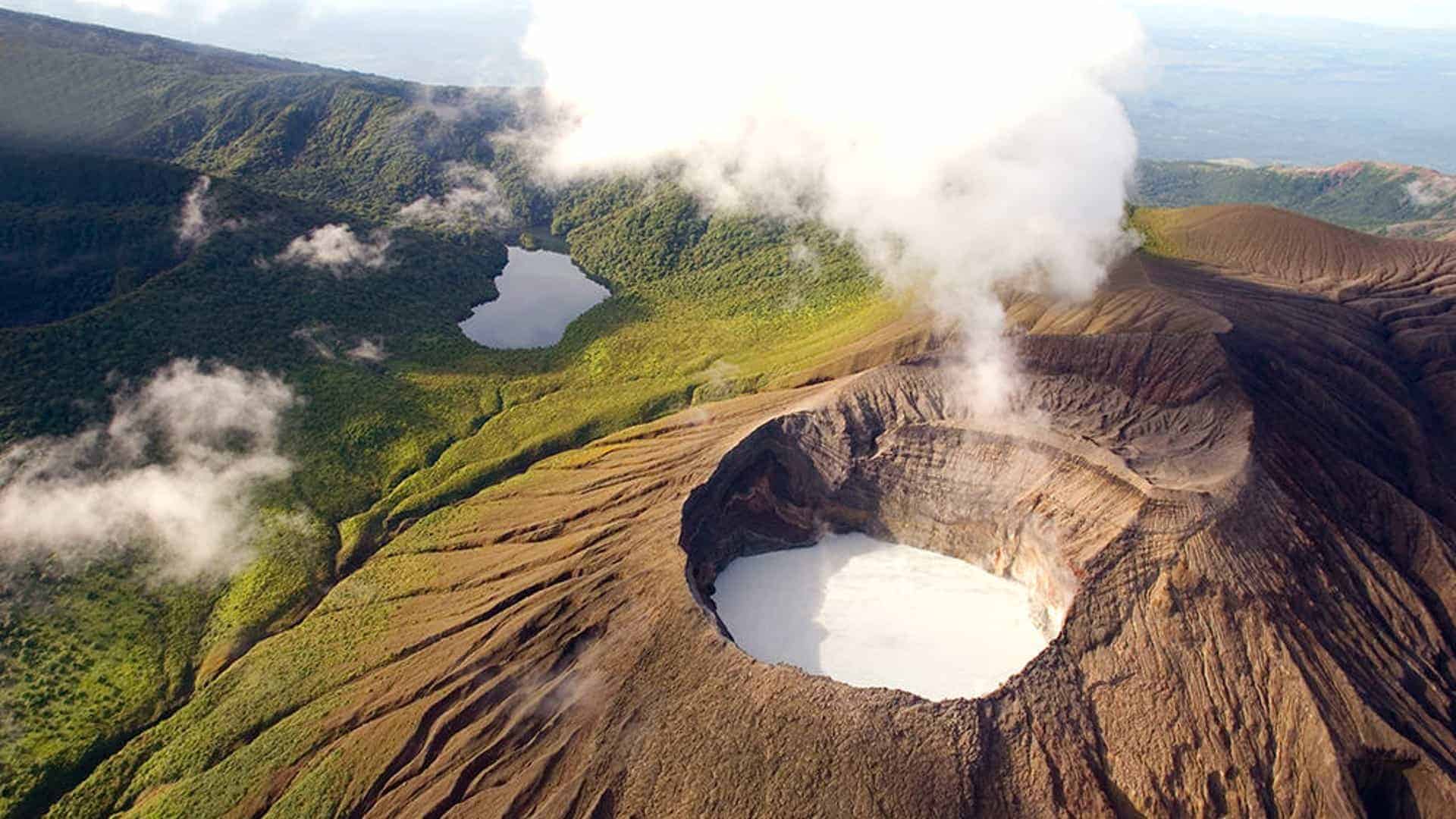Table of contents
Sloths in Costa Rica are not exactly beautiful. But like a French bulldog or a proboscis monkey, they are so ugly they’re cute.
They’re slow. They’re lazy. They’re defenseless. They can’t walk. They only poop once a week. And yet everybody loves them.
Their homely faces make them adorable – and like the dog and the dolphin, they actually smile. They’re hard to spot, but once you do, their slowness lets you watch them for a long time. Even their laziness appeals to us – hanging out in trees their whole life, eating and sleeping.
Like the panda or the koala, the sloth wins our hearts because it is so absolutely innocent and harmless. My brother once came upon two lanes of stopped traffic on a highway in Costa Rica because a sloth was crossing the road at a glacial pace. Paul got out of his car and moved the sloth to the other side of the road.
“How did you move it?” I asked.
“By the armpits,” he said.
Don’t try this with a jaguar!
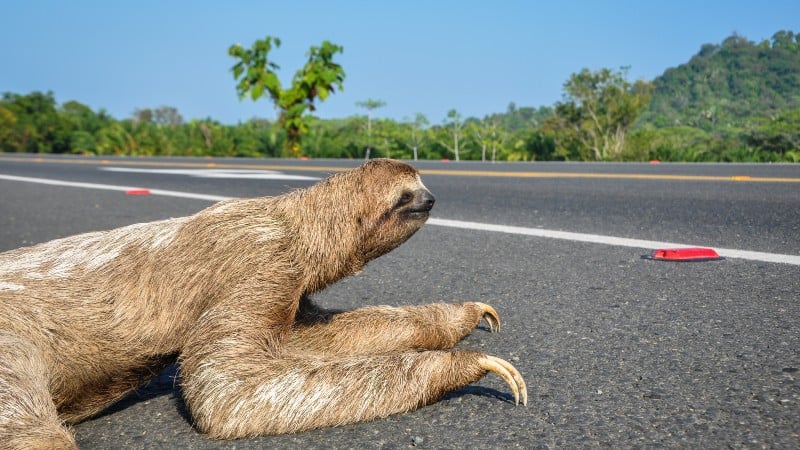
I used to live in Puerto San Luis, on Lake Arenal near Tilarán, and one night my girlfriend started shrieking in delight and shouting my name.
There was a power line that led from some trees to the corner of our house, and damned if there wasn’t a sloth inching its way along the wire toward us, upside down of course, just a few feet away. Two toes or three? Too dark – couldn’t see. I tried to take photos, damn the dark, but somehow this sloth was too fast for me and my phone.
The sloths in Costa Rica I’ve known
I’ve actually met several sloths up close and personal. I’m sure they don’t remember me, but I definitely remember them.
The first time was at the Jaguar Rescue Center near Puerto Viejo on the Caribbean, where I watched a two-toed sloth lying calmly in a basket getting her toenails painted blue. Other sloths had claws painted red or yellow, and the caretaker explained to me that this is how they identify the animals when released into the wild.
The second time was at a rescue center outside Quepos called Kids Saving the Rainforest, where a human “sloth mama” named Sam was holding an infant three-toed sloth named Chuck to her chest. The guide said he was found “crying” in a tree without her mother, and my heart almost broke to imagine the sound of this lost little sloth baby crying on his lonely branch.The third time was at the Osa Wildlife Sanctuary, where an impossibly adorable two-toed sloth munched on treats while we admired her.
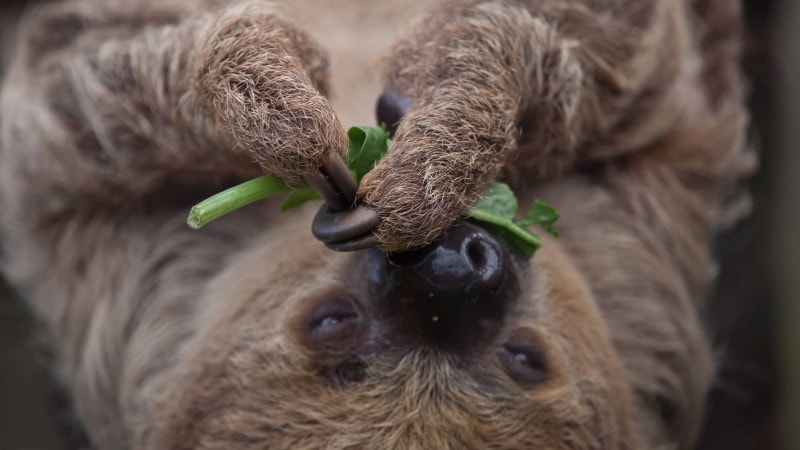
Come to think of it, I’ve never met a sloth I didn’t like..
When sloths were big
During the Pleistocene epoch, 12,000 years ago, there used to be giant ground sloths, 15 feet tall, that roamed Costa Rica alongside mastodons.
Now, 15 feet is roughly the height of the average giraffe. Ground sloths evolved along the same lines – tall enough to munch any leaves they wanted, and also big enough to intimidate predators.
Back then, let me guarantee you, nobody picked up sloths by the armpits.
Sadly, the giant ground sloth died off, along with the mastodon, apparently because of the end of an ice age. But they left their bones behind to let us know that they were here first.
Yet evolution had a way around that.
Two toes or three?
There are two types of sloths in Costa Rica today – two-toed (genus Choloepus)
and three-toed (genus Bradypus). As you might guess, they are distinguishable by how many claws they have on their forelimbs.
But you can also see the difference in their faces. Two-toed sloths are impossibly cute, while three-toed sloths are inarguably ugly – but they both “smile.”
Sloths are so slow it’s a wonder they ever have sex.
Miss Sloth: “Hey, what are you doing?”
Mr. Sloth (10 minutes later): “I’m wooing you.”
Did you know that sloths are excellent swimmers? They don’t set any speed records, but they can definitely swim across a river. That’s more than a gorilla can do.
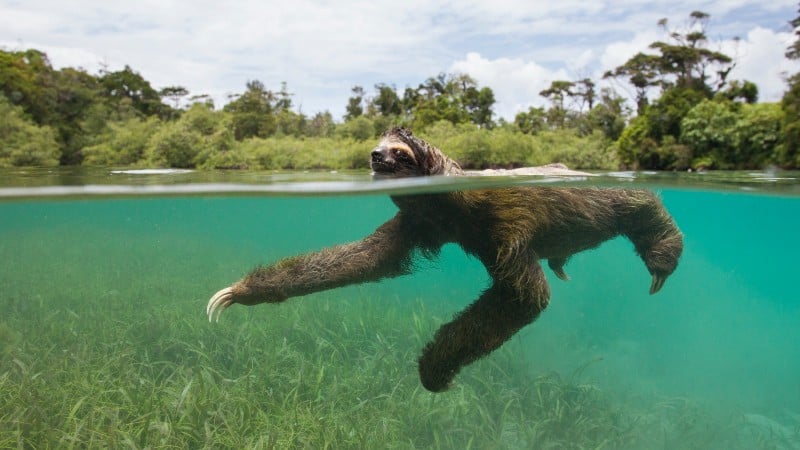
Why are they so slow? Well, you try eating leaves your whole life, and see how fast you move. Sloths have an extremely low metabolic rate, traveling maybe 40 yards a day, or half a city block.
Well-dressed sloths are covered in algae, which makes their brown or gray coats green. Sloths survive because of two defenses: They climb really tall trees, and they’re very well camouflaged.
Predators include large eagles (rare) and jaguars (very rare). The biggest threats to sloths are actually power lines and … wait for it … dogs. But dogs can’t climb trees, can they?
Subscribe to our newsletter
to stay up to date
That pooping thing
When you gotta go, you gotta go. But with sloths, there are two weird things about how they poop. No. 1, they only do it once a week. And No. 2 (no pun intended), they climb down to the ground to do it.
Mr. Sloth: “Honey, I’ve got to go down and take a poop.”
Mrs. Sloth: “Can’t you hold it?”
Mr. Sloth: “I’ve been holding it for a week.”
Mrs. Sloth: “Can’t you just poop from the tree?”
Mr. Sloth: “Nobody poops from the tree.”
Mrs. Sloth: “OK, have a good one.”
Theories? Sloth poop experts have been pondering this mystery for decades, and the best explanation I’ve found is the following.
If sloths simply shat into the air from where they hang, then their big, smelly turds would be scattered to the four winds below their favorite hangout. Then every predator would know there’s a big, juicy sloth somewhere up in that tree.
But if they descend to the ground and do their business discreetly (like a human would), then their spoor is less likely to be detected. A passing jaguar might detect the stink but not know what to make of it.
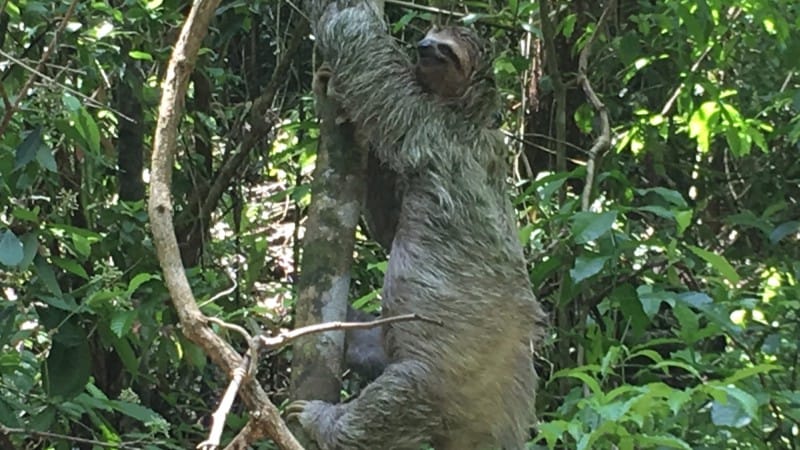
Mrs. Sloth: “Honey, how did your poop go?”
Mr. Sloth (5 minutes later): “Slowly.”
Sloth killers
Although sloths are rarely hunted, the biggest dangers to sloths are both human-related.
Sloths love power lines because they can move along them so easily, with either two toes or three. But when they touch a poorly insulated transformer, they can be killed instantly, even if that leaves sloth babies behind in the tree up above (crying, like poor little Chuck).
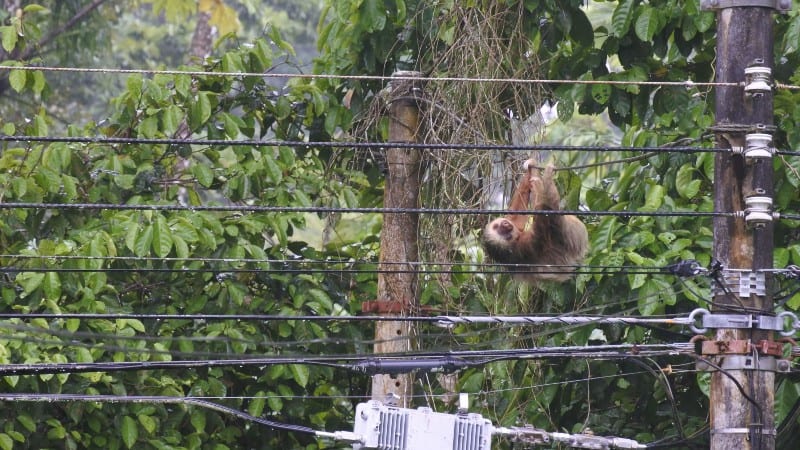
Dogs, unfortunately, don’t like sloths, so when the tree-huggers come down to the ground to cop a squat, dogs sometimes attack and kill them. It’s not like the sloths can outrun the dogs.
Cars also kill sloths when they cross highways, which they do at the speed of a turtle. Nobody ever said sloths are the smartest animals in the forest, which is perhaps another reason we love them. Dogs seem to figure out that highways are dangerous, but sloths don’t always make this connection.
Are sloths in Costa Rica dangerous?
One of the most useful things I ever read about the animal kingdom is that anything with a mouth can bite. If you don’t believe this, just ask any nursing mother.
Despite my brother’s easy experience moving a sloth off the highway by the armpits, “sloth mama” Sam Trull told me she was once severely bitten trying to feed a carrot to a two-toed sloth that had been electrocuted.
“The two-toed can be very dangerous,” she said. “They have really strong jaws, like they can chew through rocks. … They can do serious damage.”
The three-toed sloth, on the other hand, has blunt molars that don’t do much damage. “It’s kind of sad when they try to bite,” she said.

But all sloths’ mouths are full of bacteria that can be dangerous, she said, and if you’re ever bitten by a sloth, you may need antibiotics to prevent infection.
Are you listening, jaguars?
Are sloths in Costa Rica endangered?
Beloved animals are often described as “endangered,” even if they’re not. The International Union for Conservation of Nature (IUCN), the leading global authority on the conservation status of animal species, uses nine categories: Not Evaluated, Data Deficient, Least Concern, Near Threatened, Vulnerable, Endangered, Critically Endangered, Extinct in the Wild and Extinct.
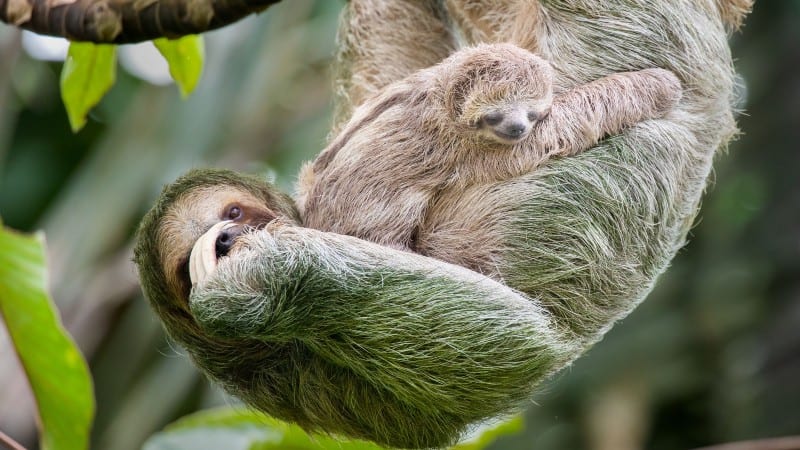
The two-toed sloth (Choloepus) is classified under “Least Concern,” as is Costa Rica’s brown-throated three-toed sloth (Bradypus variegatus). (However, the pygmy three-toed sloth, endemic to one Panamanian island, is considered “Critically Endangered.”)
That’s good news for Costa Rica’s sloths, but it doesn’t mean we should ignore threats to their safety. The biggest of these is deforestation caused by farming, logging or the expansion of human settlement. Sloths thrive in primary forest, which means forest that has never been disturbed by human activity.

Primary forest in Costa Rica tends to be so dense that the treetops touch, allowing sloths to move through the canopy from one tree to the next. In secondary forest, which has regrown after primary forest was removed, trees are often spaced so far apart that sloths have to descend to the ground to move from one to another. And that’s when sloths are at their most vulnerable.
Hey, you, get off of my line
Finally, here’s an amazing video of a child ziplining in Costa Rica who ran into a sloth. Despite the force of the collision, the sloth appears to have been dislodged not in the least. But it does look back and reach its arm out, as if to say, “Hey! I’m climbing here!”
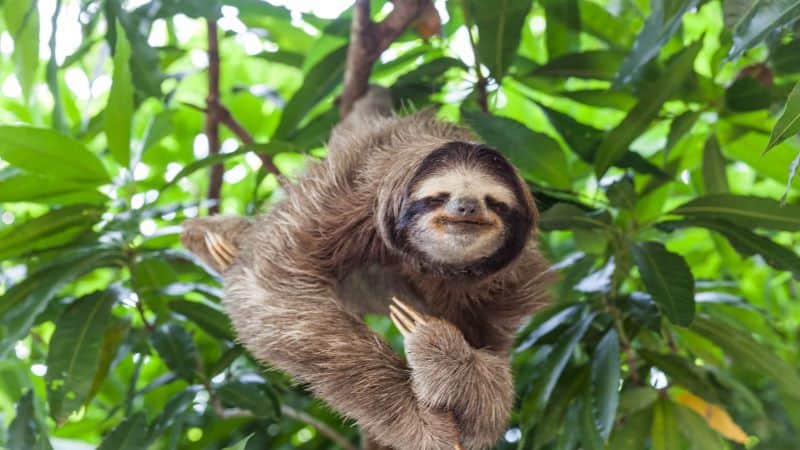
If only all human-sloth interactions could be so harmless.
Subscribe to our newsletter
to stay up to date


